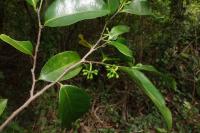This page has returned 100 entries
nipji nomu

nipjid
n. the orange tree (117); an orange, a lime, a lemon (102)
bookmarknipjid acen
n. citron; lemon; lime tree
bookmarknipjid aiyu
n. orange
bookmarknipjin
n. branch (tender)
bookmarknipjin nalmu
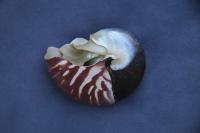
nipjin nirintal

nipjinamesei

n. Honeycomb grouper
Example: Photo by Jeffrey T. Williams / Smithsonian Institution, License: CC BY-SA 3.0 via Fishes of Australia
bookmarknipjinecei vanteigin

nipnyineuc
n. another name for "masoa"; arrowroot
bookmarkniprij

nipʧin niri

nipʧin njelas

nipʧinite

nipyipei
n. kind of plant, grass, or fern
bookmarknirac intam henain

nirak

niri

n. grass to 1 m tall, florets brown (collection: Michael J. Balick #4973)
Example: This grass is used to thatch the roof of a traditional house. Tie bunches of the grass on a stick ca. 2 m long, using string from Pandanus or other vines. Lay these on the roof and tie these sticks with grass on crossbars to secure them. The flowers of this grass are harvested and put in bags to make pillows. The flowers are soft and easy to gather and make a nice pillow.
bookmarkniri

niri atga

niri atga

niri nara

n. Blue-spotted stingray
Example: Photo by Richard Ling / Flickr.com, License: CC BY-NC-SA 3.0 via Fishes of Australia
bookmarknirid u numu

n. terrestrial fern on forest floor, growing in disturbed forest. (collection: Gregory M. Plunkett #3482)
Example: People who go fishing take this plant along with other unspecified leaves, crush them and rub them on the fishing line that the person is using. This is said to attract more fish to the bait. It is also a "message plant" to be put in a person’s hat when they come back from fishing and then people know that they caught fish. Local name means "fish gill." For performing a weather magic ritual to produce fog, this plant is fermented along with another plant (nap̃at) in a hole in a sacred stone (called "Naemoso") at a secret location on Aneityum.
bookmarknirid unmu

n. terrestrial fern, growing in primary rainforest. (collection: Gregory M. Plunkett #3614)
Example: People who go fishing take this plant along with other unspecified leaves, crush them and rub them on the fishing line that the person is using. This is said to attract more fish to the bait. It is also a "message plant" to be put in a person’s hat when they come back from fishing and then people know that they caught fish. Local name means "fish gill."
bookmarkniridunumu

niridunumu

n. terrestrial fern, growing along ridge in dense rainforest. (collection: Gregory M. Plunkett #4121)
Example: 1. The name means "fish gill". When one acquires a culture-bound illness, caused by possesion of the sea devil, this plant is used to prepare a remedy. Further information about the illness and remedy withheld.
bookmarkniriñ neyaiñ

nirinat erefera ran

niriyau
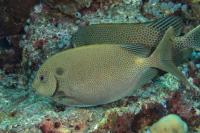
n. Goldspotted spinefoot
Example: Photo by Mark Rosenstein / iNaturalist.org, License: CC BY-NC-SA 3.0 via Fishes of Australia
bookmarknirom̃gei

nisalau
n. blossoms on breadfruit
bookmarknisasin
n. ray of light in the morning
bookmarknisbähäin
n. Dracaena angustifolia
Example: Leaf: cold maceration, emetic, taken internally against ciguatera poison
bookmarkniseaig
n. kind of tree
bookmarkniseuc
n. kind of taro
bookmarknisil
n. the center rib of the coconut leaflet; wire
bookmarknisiug
n. a tree, the leaves of which have no center rib
bookmarknisjau
n. kind of tree
bookmarknisjin
n. shoots of plants of bananas
bookmarkniskes
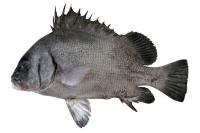
n. Harry hotlips, blubberlip
Example: Photo by ANFC, License: CC BY-NC 3.0 via Fishes of Australia
bookmarknispahos
n. coconut leaves, plaited for covering ridge of roof
bookmarknispak
n. kind of sugarcane
bookmarknispeheñ
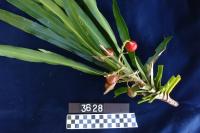
n. sparsely branched tree, 2. 5 m tall (collection: Gregory M. Plunkett #3628)
Example: This plant is used to make a grass skirt for women. There are two different methods decribed. In the first, collect the leaves, tear off 1/2 of the leaf and pleat the halves. Then dry these in the sun by hanging them from the midrib. After they are dry, weave them into a skirt. In the second, take one leaf at a time, tear the leaf down the center and throw away the midrib. The soft part is used in making the skirt by holding a piece of twine between your toes and under your armpit. Weave the length of the twine with the leaf. The let the pieces to dry in the sun for 2-3 days. The skirt can be thrown in the sea before drying to make the skirt white. Bark of inhao is usually used as twine. Retted strips of leaves, later sun dried, can be used to make pillows. When dogs or humans have fish poisoning this plant can help. Take 2 leaves and pound them (use 1 leaf for dogs) and mix with 1/4 cup of water. no further instructions given. (OR - Leaves to cure ciguatera, chew 1 leaf and swallow juice and spit out fiber. Or extract juice into a cup to drink 1x. Give juice + water in cup for dog that is sick.) There is also a belief that you can use the whole stem of this plant as a digging spade to plant sugarcane so the sugarcane is soft and sweet.
bookmarknispev
n sea snake
bookmarknisʧi

nisvahaijom
n. tree from which petticoats or skirts are made
bookmarknisyeg

n. tree, 6 m tall (collection: Gregory M. Plunkett #3574)
Example: 1. The inner bark of this plant is used as a dye or paint to provide a brown color. Boil the inner bark in a pot with a shirt and the color of the shirt will be changed to brown. 2. For toothache, people take the inner bark and mix it with sea water, and then rinse the tooth with this mixture to remove the pain. 3a. People macerate the leaves and the bark and when the tide is low, spread this in a pool of water to poison the sea shells that are edible. When they die, the eyes of this organism comes above the sand, indicating where they are, and people harvest and eat them. 3b. To attract and collect clam – NIPJINUMU – scrape bark in a pool of sea water where the clams are attracted immediately and can be collected, coming up from the sand. 4. Firewood, unspecified medical use.
bookmarknisyeg

n. tree, 7 m tall (collection: Gregory M. Plunkett #3521)
Example: 1. The inner bark of this plant is used as a dye or paint to provide a brown color. Boil the inner bark in a pot with a shirt and the color of the shirt will be changed to brown. 2. For toothache, people take the inner bark and mix it with sea water, and then rinse the tooth with this mixture to remove the pain. 3a. People macerate the leaves and the bark and when the tide is low, spread this in a pool of water to poison the sea shells that are edible. When they die, the eyes of this organism comes above the sand, indicating where they are, and people harvest and eat them. 3b. To attract and collect clam – NIPJINUMU – scrape bark in a pool of sea water where the clams are attracted immediately and can be collected, coming up from the sand. 4. Firewood, unspecified medical use.
bookmarknitai auanipin upene
n. frankincense
bookmarknitatel (a nelco)

nitato naretou

nitet
n. kind of tree
bookmarknitetan
n. a fern
bookmarknithidao
nithwunitei

tree fern, trunk 2 m tall (collection: Gregory M. Plunkett #4102)
Example: 1. There are kinds of this plant. This is considered the white one. See GMP # 4100, textit{Cyathea sp}, which is considered the black one.
bookmarknitidae

nitit a nelgo waj

nititan

n. fern to 0. 75 m, sori brown. growing along trail. (collection: Michael J. Balick #4972)
Example: The fronds of this fern are used to wrap sting ray and shark meat, which have a great deal of moisture in them, for cooking on the earth overn. Wrap the fronds (leaves) around the meat and tie with a Pandanus string. Because they are not thick, broad, entire leaves, but rather have many places in them where water can drain out during the cooking process, it is said that these leaves are much better for preparing these two types of fish, as well as any other meat that contains a great deal of moisture. For cooking on the earth over, put these wrapped foods on top of any other leaves so that they do not touch the hot stones directly, and then cover with other leaves as well. Then place the hot stones on top of these wrapped meats.
bookmarknititan cei

nititidei
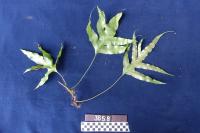
nitschatimi
n. Cordyline fruticosa L.
Example: Leaf: chew (leprosy in mouth). Whole plant: planted for several Kastom purposes; many important Kastom-bound uses as magical or ornamental plant throughout Melanesia.
bookmarknitsichäi
n. Hornstedtia sp.
Example: Subterranean part: cold maceration, taken internally against "cancer", diabetes, or as tonic
bookmarkniʧin neiang

niyeg

n. grass to 1. 5-2. 0 m tall, inflorescence white. Red clay soil (collection: Michael J. Balick #4885)
Example: Cut this grass in the morning, let dry for 2 days, and then use to weave the roof of a house. This is thicker and heavier than a coconut leaf. Also, use for cyclone house. (see photos of house) When indicating something is Tabu, tie the leaf and put it in an object like ripe bananas and people know it is Tabu and will not take it away.
bookmarkniyeg

n. grass. Found in disturbed area behind the village. (collection: Ashley A McGuigan #12)
Example: 1. To cure the sea snake (nispev) curse that causes missed periods. First the husband must combine 4 young leaves of incispev and 4 young leaves of nafanu and mash and squeeze the juice into a small bamboo (1-1.5 inch diameter) The nafanu is important because it is a plant that connects to the sea. Use wildcane leaves cover the bamboo closed. Go to the sick person and unwrap the snake from her. Start from the top and let the woman drink a small part of the potion then wash her with the mixture, making sure to wash head, elbows, knees, feet, and belly. Then take a leaf of naha and break it over the woman’s belly button to break the snake off. Smash the bamboo vessel to pieces. Leave the woman there until the wash dries on her. This takes one whole day and the ceremony in the evening so she can sleep and she must not eat. This ritual is performed by men. 2. Main plant to thatch roof of local houses. 3. Collect the dry stems, tie together, use as a torch at night for walking or walking along the reef when fishing. 4. Take 1 cane and tie the leaves together and tie on a tree to indicate tabu – e.g. a citrus tree that will be ripe soon to tell people not to pick it. 5. To catch crabs just before sunset, burn the torch and shake the ashes on the rocks; come back an hour or so later and the crabs are attracted by the ashes and you can collect them. 6. Can also use to weave walls of house. 7. Women clean the leaves of the stem and use the hard part of the stem to strip pandanus leaf before weaving a basket. 8. Cut wild cane in half and sharpen the end, use this to cut the dried pandanus leaves into small strips. 9. Tie leaves into a knot and stick the knot on the kava stem; t is means that this kava goes “express” so the carrier goes to one border of a village and passes it to another person who knows it cannot stop in this village but goes to the next border and is passed on 10. This plant is a “message plant” to say “don’t stop,” referring to something being delivered.
bookmarkniyeg

n. grass, 2. 5 m tall (collection: Gregory M. Plunkett #4071)
Example: 1. Dried leaves are used to make the thatch roofs of traditional houses. The same leaves are woven to make the walls of traditional houses. 2. When a large torch is required, many dried stems are bundled to form a flambeau. 3. The leaves of this plant are used to demarcate tabu areas. Further information about the practice withheld.
bookmarknobohtan aiyu
n. meadow
bookmarknobom

n. Bigeye scad
Example: Photo by J.E. Randall / Fishbase, License: CC BY-A-NC 3.0 via Fishes of Australia
bookmarknobot
n. a sago palm
bookmarknocirasjau

large tree, 13 m tall (collection: Gregory M. Plunkett #4052)
Example: 1. Considered to be a relative of textit{Morinda citrifolia}.
bookmarknodieg
n. a bundle of reeds; also "nohudieg"
bookmarknoducnas
n. a bunch of taro
bookmarknofar
n. a native pudding made with yam and coconut
bookmarknofauhuan
n. kind of banana
bookmarknofowai
n. river
bookmarknohap
n. kind of plant, grass, or fern
bookmark



